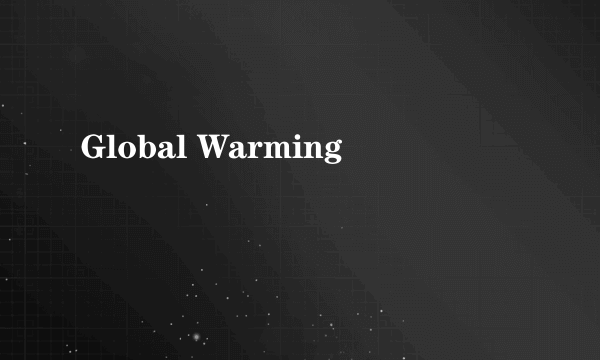Global Warming
的有关信息介绍如下:
我估计读起来比较吃力,楼主好运global warming the gradual increase of the temperature of the earth's lower atmosphere as a result of the increase in greenhouse gases since the Industrial Revolution . The temperature of the atmosphere near the earth's surface is warmed through a natural process called the greenhouse effect. Visible, shortwave light comes from the sun to the earth, passing unimpeded through a blanket of thermal, or greenhouse, gases composed largely of water vapor, carbon dioxide, methane, nitrous oxide, and ozone. Infrared radiation reflects off the planet's surface toward space but does not easily pass through the thermal blanket. Some of it is trapped and reflected downward, keeping the planet at an average temperature suitable to life, about 60°F (16°C). Growth in industry, agriculture, and transportation since the Industrial Revolution has produced additional quantities of the natural greenhouse gases plus chlorofluorocarbons and other gases, augmenting the thermal blanket. It is generally accepted that this increase in the quantity of greenhouse gases is trapping more heat and increasing global temperatures, making a process that has been beneficial to life potentially disruptive and harmful. During the 20th cent., the atmospheric temperature rose 1.1°F (0.6°C), and sea level rose several inches. Some projected, longer-term results of global warming include melting of polar ice, with a resulting rise in sea level and coastal flooding; disruption of drinking water supplies dependent on snow melts; profound changes in agriculture due to climate change; extinction of species as ecological niches disappear; more frequent tropical storms; and an increased incidence of tropical diseases. Among factors that may be contributing to global warming are the burning of coal and petroleum products (sources of carbon dioxide, methane, nitrous oxide, ozone); deforestation, which increases the amount of carbon dioxide in the atmosphere; methane gas released in animal waste; and increased cattle production, which contributes to deforestation, methane production, and use of fossil fuels. Much of the debate surrounding global warming has centered on the accuracy of scientific predictions concerning future warming. To predict global climatic trends, climatologists accumulate large historical databases and use them to create computerized models that simulate the earth's climate . The validity of these models has been a subject of controversy. Skeptics say that the climate is too complicated to be accurately modeled, and that there are too many unknowns. Some also question whether the observed climate changes might simply represent normal fluctuations in global temperature. Nonetheless, for some time there has been general agreement that at least part of the observed warming is the result of human activity, and that the problem needs to be addressed. In 1992, at the United Nations Conference on Environment and Development , over 150 nations signed a binding declaration on the need to reduce global warming. In 1994, however, a UN scientific advisory panel, the Intergovernmental Panel on Climate Change, concluded that reductions beyond those envisioned by the treaty would be needed to avoid global warming. The following year, the advisory panel forecast a rise in global temperature of from 1.44 to 6.3°F (0.8-3.5°C) by 2100 if no action is taken to cut down on the production of greenhouse gases, and a rise of from 1 to 3.6°F (0.5-2°C) even if action is taken (because of already released gases that will persist in the atmosphere). A 2007 report by the Intergovernmental Panel on Climate Change, based on a three-year study, termed global warming "unequivocal" and said that most of the change was most likely due to human activities. A UN Conference on Climate Change, held in Kyoto, Japan, in 1997 resulted in an international agreement to fight global warming, which called for reductions in emissions of greenhouse gases by industrialized nations. Not all industrial countries, however, immediately signed or ratified the accord. In 2001 the G. W. Bush administration announced it would abandon the Kyoto Protocol; because the United States produces about one quarter of the world's greenhouse gases, this was regarded as a severe blow to the effort to slow global warming. Despite the American move, most other nations agreed later in the year (in Bonn, Germany, and in Marrakech, Morocco) on the details necessary to convert the agreement into a binding international treaty, which came into force in 2005 after ratification by more than 125 nations. Improved automobile mileage, reforestation projects, energy efficiency in construction, and national support for mass transit are among relatively simpler adjustments that could significantly lower U.S. production of greenhouse gases. More aggressive adjustments include a gradual worldwide shift away from the use of fossil fuels, the elimination of chlorofluorocarbons, and the slowing of deforestation by restructuring the economies of developing nations. In 2002 the Bush administration proposed several voluntary measures for slowing the increase in, instead of reducing, emissions of greenhouses gases. The United States, Australia, China, India, Japan, and South Korea established (2005) an agreement outside the Kyoto Protocal that proposed to reduce emissions through the development and implementation of new technologies. The Asia-Pacific Partnership on Clean Development and Climate, as it is called, involves no commitments on the part of its members; it held its first meeting in 2006. Also in 2006, California enacted legislation that called for cutting carbon dioxide emissions by 25% by 2020; the state is responsible for nearly 7% of all such emissions in the United States. In 2007 President George W. Bush called for the world's major polluting nations to set global and national goals for the reduction of greenhouse gas emissions, but the nonbinding nature of the proposed goals provoked skepticism from other nations that favored stronger measures.

